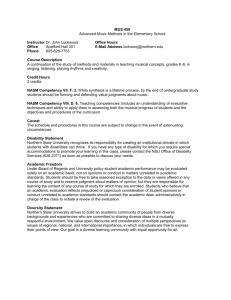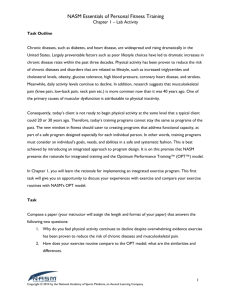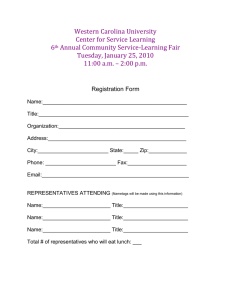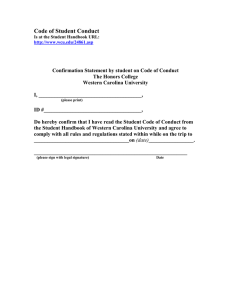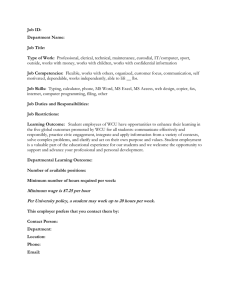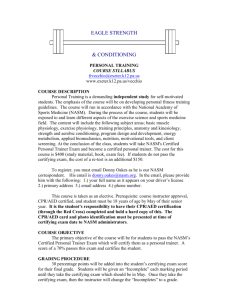Report of the External Review Team School of Music Western Carolina University
advertisement
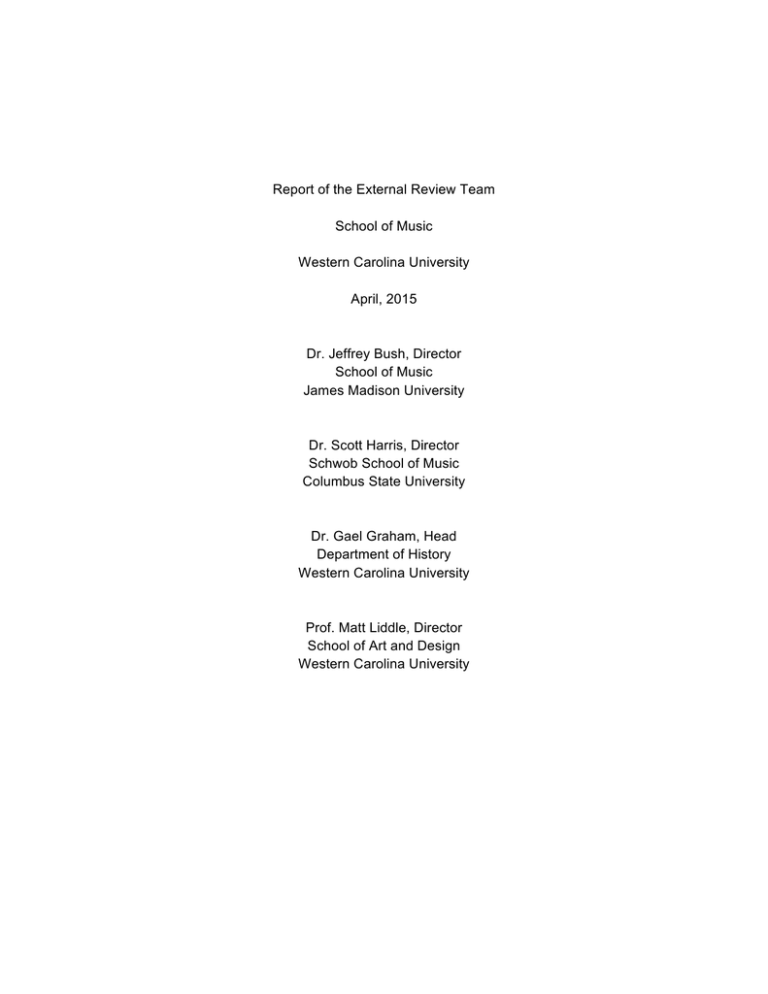
Report of the External Review Team School of Music Western Carolina University April, 2015 Dr. Jeffrey Bush, Director School of Music James Madison University Dr. Scott Harris, Director Schwob School of Music Columbus State University Dr. Gael Graham, Head Department of History Western Carolina University Prof. Matt Liddle, Director School of Art and Design Western Carolina University INTRODUCTION The external review team for the Western Carolina University (WCU) School of Music Program in Cullowee, North Carolina, visited the campus on April 12-14, 2014. The review team consisted of Dr. Jeffrey E. Bush, Professor and Director, School of Music, James Madison University; Dr. Gael Graham, Professor and Department Head, History, Western Carolina University; Dr. Scott Harris, Associate Professor and Director, Schwob School of Music, Columbus State University; and Mr. Matt Liddle, Professor and Director, School of Art and Design, Western Carolina University. Approximately four weeks before the visit, the School of Music Self-Study and site visit schedule were made available on the Office of Institutional Planning and Effectiveness (OIPE) website. Approximately two weeks later, the appendices were accessible. This document included: The WCU Strategic Plan–2020 Vision The School of Music Mission Statement The School of Music Strategic Plan 2003/2004 WCU Catalog Copy Advising Check Sheets OIPE Reports Music Course Rotation Music Faculty Roster with Credentials The School of Music Collegial Review Document The School of Music Faculty Load Report Music Faculty Resumes/CV’s A List of Music Graduates over the Past Five Years The School of Music Administrative Report Music Committee Descriptions Music-related Library Resources Major Equipment List Facilities List Unit budgets for the last three years The team was provided with an addendum (“Report on the Committee on Faculty Workloads”) during the first full day of the site visit, but was not able to review it until after the start of the 2 interviews. It was explained that, since this was not an official document but only a committee report, the school had not thought about submitting it earlier. On the evening of April 12, the review team met with Provost Alison Morrison-Shetlar. The first morning session was with Dr. John West, Director of the School of Music, who answered the team’s questions and provided a tour of most of the music facilities. This was followed by a meeting with Dr. George Brown, Dean of the College of Fine and Performing Arts, and a session with Sarah Steiner, representing the university library systems. Four sessions (afternoon of the 13th and one session on the 14th) were conducted with groups of faculty members (minus the chair). Dean Brown met with the review team again, followed by an exit meeting with Provost Morrison-Shetlar, Associate Provost Carol Burton, Dean Brown, and Director West. This meeting provided an opportunity for the review team to provide their initial feedback and for the Associate Provost to outline the process for the writing and submitting of a final report. STRENGTHS Faculty, students, and administrators all perceive the program and its personnel as key strengths: ● Dedicated faculty members express overall confidence in and appreciation for their colleagues. ● Faculty members are highly credentialed and active in the profession. ● Students and recent graduates speak highly of their experiences at WCU and specifically addressed the attention and support they receive from faculty. In many cases they developed a relationship with faculty members while they were still high school students considering where to matriculate. Faculty members serve as mentors and provide individualized instruction that students genuinely appreciate. ● Students have many opportunities to gain leadership experience within the school’s programs and activities. ● A newly appointed, energized dean is committed to outreach and fundraising on behalf of all the units in the College of Fine and Performing Arts. 3 The WCU School of Music has a number of programs and characteristics that set it apart from music units at peer institutions and/or provide regional and national visibility: ● The marching band is highly regarded, important for recruiting both for the music unit and the university, and tied to well-established summer programs that bring pre-college musicians to campus. ● The Artist-in-Residence program with the Asheville Symphony Orchestra provides important musical experiences for students and highlights the connection of the arts units on campus to the Asheville community. It is a creative approach to meet the needs of undergraduates at a school without a strings program. Additionally, it provides students an opportunity to participate in professional-level training in orchestral performance, an opportunity not available at most universities. ● The Commercial and Electronic Music program has a strong and growing regional reputation and provides students with music production options that very few schools can match, as does the Music Industry program. Location is a distinctive feature for the school: ● Marketing and recruitment materials emphasize the beauty of the physical landscape. ● The range of available outdoor activities appeals to many potential music majors. ● Proximity to the larger cultural centers of Asheville, Atlanta, and Nashville is unique among state universities in North Carolina. Key music unit priorities are identified as overall institutional goals in the university’s 20/20 strategic plan: ● Leadership in creative arts and teacher preparation: By 2020, WCU will be acknowledged as the regional educational leader in the creative arts, education of teachers and school personnel, environment and environmental policy, health professions, innovation and technology, and recreation and tourism. (p. 4) ● Ability to recruit regionally with competitive financial aid offers: The University will advocate for tuition policy flexibility for students in bordering states that surround Western Carolina's regional service area. (p. 17) 4 Curricula appear to balance rigor, breadth, and depth of studies well. Faculty told us that students and alumni consistently report that they are well prepared for professional appointments and/or further study at the graduate level. A number of specific suggestions with regard to curricula for all music degrees, identified within this report’s “Challenges and Concerns,” represent areas that would benefit from attention as the school begins the SelfStudy process for re-accreditation by the National Association of Schools of Music (NASM). The school and the college exhibit a healthy level of interdisciplinarity within the college and across the university. For instance, the College of Business supports courses for the Music Industry and Commercial and Electronic Music curricula, and the School of Music supports music instruction for the musical theatre degree. The Hunter Library provides good support for music and musical studies. Performance spaces generally serve the program well; the recent installation of video recording and transmission equipment in the concert hall will help in future marketing and outreach efforts. Once the system is up and running the entire university will benefit, as the increased visibility of high-level video and audio content on the web gains attention. The Friends of the Arts group is making headway in developing new scholarship resources for the College and in increasing the visibility of community support for the arts units. This augurs well for the further expansion of fund raising efforts and community engagement. Newly available funding provided through course fees allow for a better student experience in music, where equipment and maintenance costs for basic resources can rival the bench sciences. This year the school was able to purchase additional pianos for student practice rooms. In addition to the large ensembles, students have the opportunity to perform with multiple and varied groups such as the Tech Ensemble, the Gamelan groups, the Catamount Singers, Community Orchestra, Jazz Ensemble, and others. 5 CHALLENGES and CONCERNS A number of challenges face the music unit, as the Self-Study makes clear. In our meetings with groups of faculty members, we heard concerns that fell broadly into the categories of governance, scholarships and recruitment, facilities, office support, diversity, and curriculum. The recent cancellation of the graduate program in music continues to reverberate within the unit, both among faculty and students, but will not be addressed since that decision has already been implemented. GOVERNANCE Effective governance within the School of Music is a mutual concern of all faculty members and administrators with whom we met. A school-wide faculty retreat in January identified the following long-standing concerns: ● A lack of consensus on a plan for growth ● Faculty load equity and the reliance on consecutive overloads for full-time faculty to deliver the curriculum ● Feelings of disenfranchisement among some faculty members ● The need for transparency in decision-making Some faculty members are eager to move into a new round of planning and a future-oriented self-study process; others express skepticism regarding the likelihood of meaningful change. Questions of faculty load and equity complicate discussions of future growth. One source of ongoing tension involves the choral/vocal/piano areas and their role within a school that has a reputation centered on its band and instrumental programs. The perceived lack of transparency, particularly as related to the existing structure of the School of Music Executive Committee, seems to stem from expediency and the need to make so many decisions quickly, rather than any desire to obfuscate, yet it is a further source of tension. In the final section of this review, “Recommendations,” a number of steps are proposed to move the unit forward in addressing governance issues that will lead to the re-engaging of all faculty in a positive, productive approach to shared governance and future planning. 6 SCHOLARSHIPS and RECRUITMENT The funding for music scholarships currently available is not sufficient for the school to compete effectively for the most talented students in the region. The School of Music has documented its needs in the area of increased cash awards to be competitive with other schools in the state. If the university can negotiate for the right to award out-of-state tuition waivers for students from neighboring states, the school has demonstrated it can recruit talented students for whom WCU is a first choice and for whom the waiver will make the difference in their ability to select WCU rather than a more distant institution in their home state. [Ten public institutions in Georgia are now offering in-state tuition to students from South Carolina, Alabama, and Florida.] Related to scholarship support is recruitment marketing. Some faculty feel they are “on their own” in this area and must prepare their own marketing materials. Needs for a recruitment poster, upgraded social media support, and an enhanced web presence, were repeatedly expressed. FACILITIES In tandem with the generally favorable view of music facilities on campus, which include highly regarded recording facilities in the CAT Center, we heard specific concerns about some inadequacies. These included: ● potential health issues (the presence of mold) in the large rehearsal room, which must be addressed ● a need for more storage spaces for student instruments ● vacillating humidity rates within the Coulter Building damages instruments over the long term and lead to increased maintenance costs ● sharing a facility with the Department of English (which finds sound isolation less than fully effective), while currently a reality, is not ideal ● a need for sound-proofing the large rehearsal room so that there is no sound bleed from this room to the recital hall ● some interior spaces in Coulter would benefit from further retrofitting and renovation to serve the school’s overall professional appearance and longer-term aspirations 7 OFFICE SUPPORT Another half-time position is planned to deal with the extensive workload required to manage the School of Music. In addition to the documentation provided by the School of Music, this request is justified by national data provided by NASM. The average staff support for a music unit in a public institution with 100-200 majors, as reported through the NASM Higher Education Arts Data Services (HEADS) Data Summaries, 2014-15, is: Average Total FTE Administrative Staff 2.52 Professional and Miscellaneous Staff 1.23 Technical Staff .96 (The category of “Library Staff” is omitted here.) DIVERSITY The committee noted the lack of diversity of instructors at all ranks. Gender diversity and pay equity were raised as issues during meetings with faculty. In future hiring, the School of Music will need to pay particular attention to addressing diversity among its faculty. The school is encouraged to examine equity and compression issues among existing faculty lines using the NASM HEADS data and results of the WCU institutional study of gender equity in compensation. CURRICULUM With a forthcoming NASM review, the school will want to review, document, and in some cases strengthen its approaches in the following areas: ● Coordination of instruction within the theory course sequence and among the sequences in theory and aural skills ● The threshold passing grade of D- may hamper the effective progression of students in sequenced courses ● The study of improvisation/composition and music of other cultures for all music majors ● The incorporation of music technology across all curricula 8 Music education students expressed specific concerns with regard to: ● CEAP courses that are perceived to be less useful than music content courses ● Ability to support student teaching placements beyond a specific area may hinder access of music students to placement in some of the stronger music programs in the region. OPPORTUNITIES The external review committee sees many opportunities for the WCU School of Music; some arise from challenges, some from expanding upon strengths. Many are already on the minds of new leaders in the school and college, who are prepared to seek counsel from faculty in the coming months as they begin to pursue new opportunities. The WCU School of Music will soon prepare for a thorough examination of its current programs and the development of a plan for the future through the NASM Self-Study. That process, in and of itself, may promote substantial changes. The process will involve a review of policies and procedures, and, where those are not explicitly defined, will assist the unit in establishing and documenting policies for the future. These are some opportunities we believe the school should explore further and/or consider for the future: ● The school can use the NASM accreditation process as a catalyst for reviewing all aspects of the unit’s operations, from its mission to its mix of degree programs to its service to non-majors. NASM offers many resources that all faculty members and administrators can access that are helpful. Numerous policy studies and recommendations are available for download at: http://nasm.artsaccredit.org/index.jsp?page=Assessment%20and%20Policy%20Studies ● Commercial music, music industry, and entrepreneurship in music studies are all potential growth areas, and may play a distinctive role as the Dean develops the idea of creative place-making. 9 ● As the school looks to define its role within the region of Asheville, Waynesville, and the Highlands, it may be able to partner with WCU’s Hospitality and Tourism Program in developing innovative programs. It can look to the Biltmore campus as another opportunity to showcase the work of faculty and student musicians. These opportunities can be explored from a development perspective as well. ● The Friends of the Arts can help lead a broader dialogue about the arts in the region. ● Extending some of the training available within the Commercial and Electronic Music and the Music Industry programs across all degree programs would make those students in the performance, music education, and Bachelor of Arts in music programs more versatile as compared to music majors at other universities. ● Additional minors may also extend the reach of these programs where additional capacity exists. ● The school has the opportunity to increase generated student credit hours by offering more courses such as “History of Rock” for the general student population. ● The regular touring regimen of the instrumental ensembles and the music industry ensemble, the Catamount Singers and Electric Soul, could be expanded through the addition of choral/vocal programs that could tour in tandem; i.e. go to the same schools to work with different student populations. RECOMMENDATIONS Recommendations in this report grow out of our thoughts and ideas about how to respond to the challenges and concerns, and what next steps may arise from the opportunities, which have been identified. In some cases we are endorsing ideas already adumbrated or fully stated in the Self-Study. NASM and the SELF-STUDY PROCESS The school should use the forthcoming NASM self-study process over the next two years as a structured means of planning systematically for the future. Some of the work needed for a SelfStudy has already been substantially completed—for instance, the library report should be sufficient for the NASM Self-Study with the addition of an annual acquisitions budget. 10 A core group of music faculty should begin this summer to familiarize itself with the NASM Standards, available in the NASM Handbook as well as consider the various formats that a SelfStudy may take. The process will naturally lead the faculty to consider various responses to standards referencing the curriculum in particular; some of those are indicated in this report and some will arise organically out of the review process itself. NASM Handbook: http://nasm.arts-accredit.org/index.jsp?page=Standards-Handbook NASM Formats: http://nasm.arts-accredit.org/index.jsp?page=Formats GOVERNANCE A short-term goal should be the establishment of the Director of the School of Music as a true full-time position. A full-time faculty line as Director of Bands is also of importance in maintaining current strengths within the school. Another short-term goal should be a reconsideration of the role and membership of the Executive Committee. At a minimum, minutes from meetings should be shared with faculty, but the unit may also want to consider broadening the membership while paying attention to the representation of different constituencies within the school. As the school takes up fuller consideration of the report on faculty loads, it may want to consider bringing in a NASM consultant who has direct expertise with multiple approaches to calculating faculty loads. Information of the purposes and expenses associated with a consultative visit can be found here: http://nasm.arts-accredit.org/site/docs/Other%20Forms-NASM/ConsultativeVisits-NASM.pdf The guidelines offered within the NASM Standards provide wide latitude in the determination of faculty loads within music. The experience of the external evaluators suggests that it is not unusual that music course loads are heavy in teaching contact hours when compared campuswide within institutions. Nevertheless, the extended reliance on loads that exceed 13 hours per semester should be examined carefully. A range of approaches may develop over time; these might include the re-assignment of courses to part-time faculty, a banking system for credit for Independent Studies, release time that can accumulate over several semesters, the reassignment of advising loads based on teaching loads (i.e. if heavy in teaching, a lighter advising load), and so on. 11 The NASM Handbook 2014-15 provides the following guidelines in the determining music faculty teaching loads: (1) Institutions use a variety of methods for calculating teaching loads. The choice of method is the prerogative of the institution. (2) Policies concerning loads should be clearly developed and published with regard to the variety of educational, artistic, and administrative duties undertaken by music faculty, and any conversions between clock hours and credit hours. (3) Institutions vary significantly in the amount of time they expect faculty to devote to instructional and other responsibilities such as composition and performance, research, and community service. The following statements about two types of instructional responsibilities, therefore, provide indicators, not rules. Classroom instruction in lecture/seminar format is weighted differently from private studio lessons in calculating the teaching component of faculty loads. Normally, the upper limit for a full load for classroom instruction in a lecture/seminar format is approximately 12 clock hours per week; for private studio instruction, approximately 18 clock hours per week. (4) Music faculty teaching only classroom/seminar courses should have their load determined in the same way as faculty in other departments of the institution. (5) All faculty should have sufficient time for artistic, scholarly, and professional activity in order to maintain excellence and growth in their respective areas of expertise. (6) Normally, the teaching loads of those having administrative and/or consultative duties are appropriately reduced. Guideline number two is particularly relevant; the school is encouraged to work toward a document that establishes and publishes policies that promote fair and flexible load assignments. OUTREACH and RECRUITMENT Recruitment should be viewed as a shared responsibility among all faculty members. Travel in the region for recruitment activities should have a high priority for funding and faculty should know that travel expenses will be covered. Expectations for recruiting should be delineated in position descriptions as faculty searches are developed. Studio faculty should have a general 12 recruitment plan for their area prepared in consultation with the director. Any planning for growth should be accompanied by a plan for recruitment and outreach. Numerous ideas arose in our discussions that seem ripe for further discussion and planning in the areas of outreach and recruitment: ● Additional summer camps and institutes, particularly in relation to vocal and choral activities, should be considered as a primary means of recruitment as well as a source of revenue within the College of Fine and Performing Arts. ● The School of Music should consider: —restoring the Honors Band program —adding on-campus experiences and tours for choral programs —building a presence in Asheville around small, portable concerts appropriate for smaller venues that feature voice and piano —sending more small popular music ensembles on short tours ● The school is doing a good job of tracking alumni placements and is encouraged to make further efforts to stay in touch with them in a systematic way and present their accomplishments as a part of recruitment and outreach materials. ● The Asheville and Highlands connections with the School of Music are important for the cultivation of prospective new donors and can be used for: —off-site performance venues —highlighting faculty and student work in lectures, performances, and exhibitions —gaining statewide visibility for WCU music and art programs ● Encourage ways to market the school’s programs as “the band AND….” which can emphasize the many positive aspects of the existing band program while highlighting that the school offers much more, an abundance of opportunity that benefits every student musician. ● Find ways to enhance and build upon the unique Artist-in-Residence relationship with the Asheville Symphony Orchestra. The program should be featured prominently in recruitment and promotional materials. ● Build a cooperative relationship with the development office that emphasizes opportunities to engage donors for additional support for music scholarships. ● Tout the burgeoning reputation of the Commercial and Electronic Music and the Music Industry programs better regionally—could they have a significant presence, for instance, at the annual singer/songwriter festival in Nashville? 13 VISION The following recommendations are meant to assist in clarifying a vision within the region, within the university, within the college, and among the constituencies within the school: ● The Dean has a vision of creative place-making that will need some time to take root in the culture of the institution. We believe this can, in time, develop into a transformative vision for the college. We recommend that the administration find ways to support the Dean’s regional initiatives. ● The university’s fund raising staff should integrate the arts activities on campus and in Asheville into their activities in as many ways as they can. With the performing and visual arts being so high profile in the Asheville community, a natural linkage exists that the development office should highlight at every opportunity. ● We heard one idea expressed in several ways: that Western Carolina University be a leader in music education in the state. This concept should be re-evaluated to determine if it is still practical and desirable. Would this require a genuine focal point in the form of a faculty position dedicated exclusively to music education? The leadership position may be hard to achieve with many faculty wearing several hats, and with a good portion of the music education curriculum, including evaluation of student teaching, handled by part-time faculty. Having full-time faculty evaluate student teaching on-site is a natural way to build relationships with the best school music programs in the western part of the state. ● The school will be engaged in discussions about models for growth in the near future. As the discussions evolve, they could productively focus on the following questions: Would a growth in student credit hours generated, independent of a growth in numbers of majors, bring additional financial support and support for faculty lines to the school? Would additional numbers of music minors bring additional financial support and support for faculty lines to the school? What model of growth is appropriate?: —a model that is based on “ideal” studio sizes —a model that is based on “ideal” ensemble sizes —a model that is based on “ideal” class sizes in the music education 14 curriculum, which is the most populous major —a model that is based on new investment in the strongest programs in the unit —a model that is based on new investment in those programs which are falling behind in the unit, to allow them to develop into strengths —a model that grows through the strategic addition of new programs Such a strategic planning discussion may be most easily accomplished with an outside facilitator to lead the process. TEACHING and LEARNING These recommendations are made within the overall framework of undergraduate curricula that function well and meet the needs of students. Again, some of them are meant to identify areas that NASM will ask that the institution address. We recommend that the school: ● Take a careful look at the course sequences in aural skills, piano class, and music theory to be sure they are effectively sequenced and coordinated. ● Review in detail the vocal/choral and piano areas with attention to consistent funding for opera scenes productions, opportunities for voice students to work with professional coaches, and the relationship with the musical theatre program. Some interesting synergies could develop in these two areas with the piano program as well. ● Review the NASM standards relating to music technology (in the context of how it is infused into the curriculum for every student), music of other cultures, ensemble experiences within groups of various sizes, and composition/improvisation in the early stages of preparing the Self-Study. ● Consider music education licensure needs with regard to voice students needing an instrumental experience and instrumental students needing a choral experience. 15 ================================= We thank the faculty, students, and administrators with whom we met for their forthrightness and their willingness to engage in substantive discussions oriented to helping the Western Carolina University School of Music use this review process to improve the academic unit. Jeffrey Bush Scott Harris Gael Graham Matt Liddle 16
